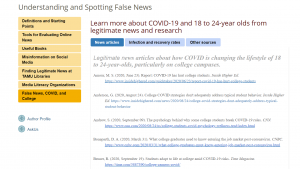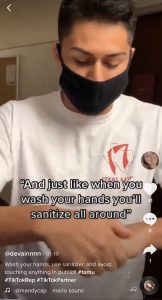COMM students tackle Covid-19 Misinformation with Facts
As the defining event of 2020, the pandemic has generated countless news articles and health prevention messages, including misinformation. The students in COMM 460 and 305 tackled ‘fake news’ and effective prevention facts about COVID-19.
By Hannah Brennan

COMM 460 created a libguide with citations to resources about COVID-19 fake news and recovery rates.
Students in two COMM classes took on how COVID-19 information has been communicated, with one class identifying “fake news” while the other competed to create effective prevention messaging.
As the defining event of 2020, the pandemic has generated countless news articles and health prevention messages. The students in COMM 460 and 305 created ways to identify misinformation and ways to provide health prevention facts that connected with peers.
Randall Sumpter, Ph.D., said the assignment in Communication and Contemporary Issues grew from student interest about misinformation surrounding coronavirus.
“In our class discussions we started speculating there ought to be a lot of fake news stories about COVID-19, and it would be interesting to track those down and accumulate them in one place,” said Sumpter, associate professor of communication at Texas A&M University. “We were able to collaborate with Stephen Bales at the library about adding the fake news stories we found to a libguide site.”
Libguide is short for library guide, an online resource created by subject librarians to aid researchers navigate the library systems’ electronic journals and databases, said Bales, a social sciences and humanities librarian at Texas A&M. The 21 students from Sumpter’s COMM 460 Fake News class compiled a list of 55 citations from legitimate news and research sources about how COVID-19 has affected 18- to 24-year-olds, infection and recovery rates, and misinformation on COVID-19, he explained. The students also used these resources to complete their class research projects.
“With fake news throughout the pandemic, people have been given misinformation about medical treatments or properly conducting safety measures,” said Jeremy Johnson, a senior communication major enrolled in the class. “This creates an infodemic, which created a second pandemic for us and cost some people their lives.”

Students from COMM 305 created a TikTok highlighting the importance of washing hands after performing everyday tasks. View the TikTok here.
Lu Tang, Ph.D. and associate professor of communication at Texas A&M, said she challenged students from her COMM 305 class to create COVID-19 prevention health messages targeted to Aggies and Aggie families. The team of students that accumulated the most ‘likes’ on their post received bonus points, she added.
“I think a competition was the best thing to do because it was the class project I actually cared about,” said Laura Torres, a senior communication major at Texas A&M. “I care about all my class projects obviously, but this one was a competition and has to do with a current problem in my interest.”
Torres and her group made a TikTok about remembering to sanitize after doing simple, everyday tasks, she said. Kristina Gantz, her team member, said they used factual information in the video to combat the misinformation on social media about COVID-19.
“I think that it’s important to hear it come from another college student, asking people our same age to take it seriously,” said Angelino Pangilinan, a junior at Texas A&M.
To visit the class libguide, click here.
To watch the TikTok, click here.
- Dept News
- Aggie
- Aggie Families
- Angelino Pangilinan
- Communication and Contemporary Issues
- Coronavirus
- COVID Recovery Rates
- COVID Texas A&M
- COVID-19
- Department of Communications
- Fake News
- False Information
- False News
- Hannah Brennan
- Health Communication
- Health Communication Research
- Health Research TAMU
- Infodemic
- Jeremy Johnson
- Junior
- Kristina Gantz
- LibGuide
- Library
- Library Guide
- Library Resource
- Lu Tang
- Misinformation
- Pandemic
- Randall Sumpter
- Recovery Rates
- Safety Measures
- Sanitize
- Senior
- Social Media
- Stephen Bales
- Texas A&M
- Texas A&M Class Project
- Texas A&M Libraries
- Texas A&M Library
- Texas A&M Resource
- TikTok
